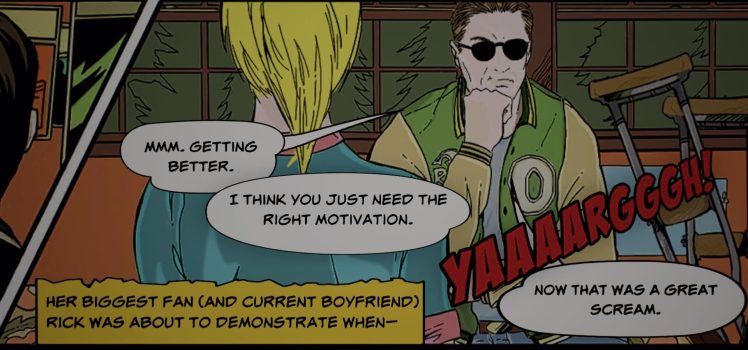What Remains of Edith Finch is Art.

Let’s get the pretentiousness of this post started off right: Is What Remains of Edith Finch art? Now, let me ratchet up the insufferability by immediately answering the question with a non-committal, pseudo-turn into armchair psychology: Maybe.
I’ve been an “art guy” all my life (see also: guy who says he likes art, but more often than liking it, he likes to talk about it in ways that involve the word “pseudo” while diminishing its highly skilled observers and critics as people who apply themselves as long as it doesn’t disrupt chair sitty time(( That was a really long joke. I apologize for leading you down a path that ultimately didn’t arrive anywhere worthwhile. ))). I was the guy who could kinda draw famous cartoon characters in grade school. In high school those creations turned toward the angsty and introspective—”no, that’s not Bugs Bunny. That’s a mechanical representation of, and therefore Capitalism commentary on, Bugs Bunny…as a girl.” In College I fell into writing, and with my years of socially informed cartoon art, the words came backed with intentional thought, and so throughout I maintained the art guy reputation.
But for all this time of studying, defending, and creating art, nothing froze my synapses more than trying to define what I was doing. Had my title ever appended “professional”, I might have been more confident. Or at least as a “professional art guy” I could have avoided arguing a definition entirely by leaning into the money-making side. “I get paid to write scripts,” or “I get paid to curate museums,” sounds better than “I get paid to art.”
But then someone, though I can’t remember who, revealed to me a definition that perfectly suffocates all of the pesky nuances:
Art is anything that is framed and presented for contemplation.
“Framed,” meaning, articulated for visibility. See also: staged (theatre), projected (movies), maybe bouqueted (flowers), maybe shellacked (collages). Maybe shellacked, again (dead body parts on a wall).
“Presented,” meaning, put on display. Meaning, purposely given an audience. Meaning, audience is important.
“For contemplation,” meaning, a responsible party (either the creator or the curator) intends for others to consider the thing, to think about it, to, well, contemplate it.
No Frame or no audience or no intent = no art.
Let’s challenge this.
That commercially produced poster hanging on the wall in the restaurant? Well, given that it’s been produced with intent, that satisfies the “framed” requirement. Hanging it on the wall in a place meant for viewers satisfies the “presented” requirement. The restaurant owner may or may not have wanted viewers to contemplate it, but here we’ll assume this restaurant owner is your childless aunt who points out the poster to every single new customer and asks “isn’t that funny,” so yes, it’s art. Commercially produced art, but art nonetheless.
What about when that poster gets ripped from the wall and tossed in the trash can? Is it still art? No. It’s no longer intended for an audience.
If someone lifts that poster from the trash and staples it to a bathroom wall. Yep. Art.
This simplicity is probably offensive, I understand. It’s scary to think of something so important to so many as something attainable by any crazy person on the street corner holding a megaphone and a bag of dog poop. But to those offended, I suggest you get over yourself. Don’t worry. Your precious art is still worthy of high-falutin snootery. Though we’ve broadened the defition of art to include your spastic nephew’s found gum wrapper diarama, we can still argue about the quality of the art. Yay for cultural gatekeeping!
A great piece of art reveals the audience’s ignorance.
A great piece of art shows you, the audience, things you didn’t know you didn’t know. Importantly, though, it asks and gives some guidance, but it never answers.
Is What Remains of Edith Finch art? Yes. It’s framed (that’s essentially the Art Director’s job; therefore, the existence of an Art Director = framed). It’s presented (it’s made for a game console or PC). It’s meant for contemplation (you’re damn right it is).
Is What Remains of Edith Finch good art? Yes. This game taught me more about the power of narrative than four years spent seeking an English Degree in college. Though that degree, and the experiences surrounding it, continue to be incredibly strong anchors for my approach to reading, writing, and thought, it wasn’t until playing What Remains of Edith Finch that I was encouraged to question what story is so important to human survival.
Truly. Survival. I’m not exaggerating.
Humans use story to justify their actions. Without justification other humans cannot anticipate action and therefore cannot form coherent societies and strong bonds within those societies. What Remains of Edith Finch narrows this concept all the way down to the family unit. This game explores how narrative can be used with good intent to form such bonds, but also how narrative can fracture trust by challenging facts.
What Remains of Edith Finch is art. It’s good art.


